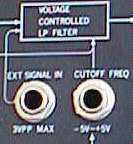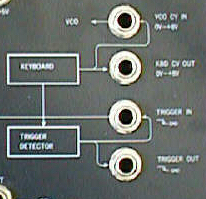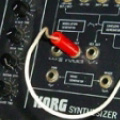OTHER FEATURES
 PORTMENTO: Also known as a slew limiter or (in the case of the MS-50) an integrator. It’s hard wired between the keyboard CV and the VCO. Also, portamento is output via the KBD CV OUT, so it can be used when controlling another MS series instrument (or whatever is being controlled).
PORTMENTO: Also known as a slew limiter or (in the case of the MS-50) an integrator. It’s hard wired between the keyboard CV and the VCO. Also, portamento is output via the KBD CV OUT, so it can be used when controlling another MS series instrument (or whatever is being controlled).
EXTERNAL SIGNAL: This is the level control for the input of a signal from, say, a drum machine, another keyboard, a vocal, etc., for signal processing within the MS-10. The input is labeled “EXT SIGNAL IN” and is located in the VCF section of the patch panel. Note the signal flow diagram: the external input goes directly into the LP Filter, then into the amplifier.
 Use is fairly simple: plug in an external input, then adjust the level control. The catch is that VCA is still hard wired to the Envelope Generator, which is triggered by the keyboard or by an external trigger input (must be a Korg trigger, like from another MS series instrument). In other words, to hear an external signal input, a key must be played or an external trigger provided.
Use is fairly simple: plug in an external input, then adjust the level control. The catch is that VCA is still hard wired to the Envelope Generator, which is triggered by the keyboard or by an external trigger input (must be a Korg trigger, like from another MS series instrument). In other words, to hear an external signal input, a key must be played or an external trigger provided.
There is no way to disable or turn down the VCO level. So, even if using an external trigger source, it’s not possible to hear the external signal without also getting the VCO. This design oversight severely limits the MS-10’s functionality as an external signal processor (unlike the MS-20), but there is a way around this! Here’s how:
- In the VCO, select the Pulse (Square) waveform.
- Turn the PW/PWM knob all the way clockwise, or until the note can no longer be heard. You have disabled the VCO and can process your external signal without interference. (Why does this happen? If the pulse width is adjusted to the extreme, the period of the waveform becomes less and less until it effectively disappears.)
 In addition to the noise waveform available in the VCO, there are two additional noise sources available in the patch panel: pink and white. Pink is basically a filtered, darker form of white. These noise outputs can be used as a modulation source for just about anything, but they’re probably most useful when used to modulate the VCF cutoff frequency, to produce anything from explosions, to thunder, to sizzling bacon.
In addition to the noise waveform available in the VCO, there are two additional noise sources available in the patch panel: pink and white. Pink is basically a filtered, darker form of white. These noise outputs can be used as a modulation source for just about anything, but they’re probably most useful when used to modulate the VCF cutoff frequency, to produce anything from explosions, to thunder, to sizzling bacon.
MODULATION WHEEL: A modulation source for manual control of modulation during live performance. The wheel is not pre-patched to anything, so in order for it to be used, it must be patched via the patch panel to a modulation destination.

Possible modulation destinations include all the usual suspects, keeping in mind that the wheel outputs from -5V to +5V:
- VCO, to add vibrato
- Pulse Width Modulation, to manually control the Pulse Width.
- VCF, to control the filter.
- VCA, to add volume (note: the VCA accepts inputs of from 0 to +5V, so any adjustment of the wheel from center on down is ignored).
CV/TRIG INPUT/OUTPUT
 The keyboard control voltage output (KBD CV OUT) is the most commonly utilized modulation source: as it’s hard wired to the VCO, every time a note is played on the keyboard, a control voltage electrically corresponding to the note being played modulates the VCO, affecting the pitch it produces. Via the patch panel, it can also be used as a modulation source to affect the VCF cutoff frequency, the VCA, or VCO pulse width. Modulation of the VCF cutoff frequency (KBD CV OUT patched to VCF CUTOFF FREQ input) is a useful effect, and is standard on most analogue synths.
The keyboard control voltage output (KBD CV OUT) is the most commonly utilized modulation source: as it’s hard wired to the VCO, every time a note is played on the keyboard, a control voltage electrically corresponding to the note being played modulates the VCO, affecting the pitch it produces. Via the patch panel, it can also be used as a modulation source to affect the VCF cutoff frequency, the VCA, or VCO pulse width. Modulation of the VCF cutoff frequency (KBD CV OUT patched to VCF CUTOFF FREQ input) is a useful effect, and is standard on most analogue synths.
The KBD CV OUT is always available, whether or not a key is being pressed. The voltage it outputs corresponds to whatever the last note played was, and stays that way until another note is pressed.
The TRIGGER OUTPUT outputs a “high” voltage (around 5 ~ 8 V) until a key is pressed, at which point it drops to 0 V until the key is released.
INTER CONNECTIVITY: MS TO MS
Using the MS-10 to “play” another MS-10 or an MS-20 couldn’t be easier: KBD CV OUT to VCO CV IN and TRIGGER OUT to TRIGGER IN.
Similarly, the MS-10 is fully compatible with the other machines in the MS line: the MS-50 (modular), the SQ-10 (analogue sequencer) and the VC-10 (vocoder).
The KBD CV OUT of the MS-10 is also fully available as a modulation source for the 20 or the 50. For example, one could patch the MS-10’s KBD CV OUT to the cutoff freq input of the MS-20’s high pass filter, while patching the MS-20’s KBD CV OUT to the cutoff freq input of the MS-20’s low pass filter, to “play” both filters in real time — one from each keyboard. (This might sound a little strange, but it’s incredibly useful when using the 20 for external sound processing.)
INTER CONNECTIVITY: MS TO REST OF THE WORLD
Here’s where things get tricky. In pre-MIDI days, several competing standards for keyboard inter connectivity existed. While almost all synth manufacturers used some form of control voltage to define pitch, and some concept of a gate or trigger to signal note on and note off (which is only logical, as they all subscribed to the basic Buchla idea of sound synthesis based on voltage control), they couldn’t quite agree on the exact technical definitions. Without getting too philosophical, here’s a brief explanation of the various standards. If you couldn’t care less, skip down to MAKING IT WORK.
UNDERSTANDING CONTROL VOLTAGES. There are two common “standards” for keyboard control voltage: linear and exponential. All VCO’s start out life as linear — the increase in voltage is directly proportional to the increase in pitch (which is why it’s also known as the hertz/volt system). This is the easiest way to realize voltage control electronically. However, the relationship between the frequency of a sound (hertz) and the pitch that the ear understands is exponential — A2 is 110 hertz, A3 (one octave up) is 220 hertz, A4 is 440 hertz, etc. Therefore, to make the relationship between the keyboard control voltage and the pitch more logical, many companies decided to adopt a 1 volt per octave standard. This is achieved electronically by running the voltage through a logrimithic converter before it’s fed into the VCO, hence why this is called the exponential system.
WHO USES WHAT? The exponential, or “1 volt per octave” system is by far more common. It was used by Moog, Arp and Roland, as well as by most new analogue manufacturers, including Doepfer and Serge. Also, many new rackmount MIDI controlled analogues that output CV and gate, such as Waldorf and Novation, use the 1V/Octave system. EML, interestingly, went with the exponential system, but somehow came up with a different ratio (1.2V/octave). The only major proponents of the linear system were Korg and Paia (although new Paia gear, like the Fatman and their new modulars, is exponential).
GATES AND TRIGGERS. The term “Gate” usually refers to a control voltage that changes state (low to high or vice versa) when a key is pressed, and stays that way until the key is released. “Trigger,” on the other hand, usually refers to a very brief gate (a cv spike), that can come from a keyboard or an LFO or any other source. Although the MS synths use the term TRIGGER, they output a Gate (i.e. the CV doesn’t change back to normal until the key is released).
GATE STANDARDS. The gate output of Moogs, Arps, Rolands and Doepfers is 0 Volts until a key is pressed, then it jumps up to a “high” state (around 5V) until the key is released. This is commonly called an “V” trigger. Korg, of course, is different: the normal state is “high” (around 5V), and it drops to 0V when a key is pressed. This is commonly called an “S” trigger.
MAKING IT WORK. By far the easiest way to connect an MS series instrument to the rest of the world is to locate a Korg MS-02 interface. Failing that, one can take advantage of a strange design feature of the MS-10 and the MS-20: the VCO frequency CV input is an EXPONENTIAL input (it’s labeled right there on the patch panel as such!!). The process is as follows:
- Patch the performance wheel cv output to the keyboard CV input (to disable the pre-patched keyboard to VCO connection).
- Patch the exponential CV out of the “master” keyboard (or MIDI to CV controller) to the VCO FREQ IN of the MS-10.
- Play a note on the master keyboard (making sure to trigger the MS-10!! See below.) and adjust the VCO EXT. modulation level until it’s about in tune. Play notes in octaves on the master keyboard and adjust the modulation level and the VCO tuning on the MS-10 until the tune and scale are correct.
Of course, this is only HALF THE BATTLE. The “V” trigger of the master keyboard must be converted to an “S” trigger to trigger the MS-10. This can be accomplished in many different ways, some of which are:
- Use the External Signal Processor on the MS-20.
- Use a trigger inverter (e.g. the Doepfer A165).
- Build a simple converter.
